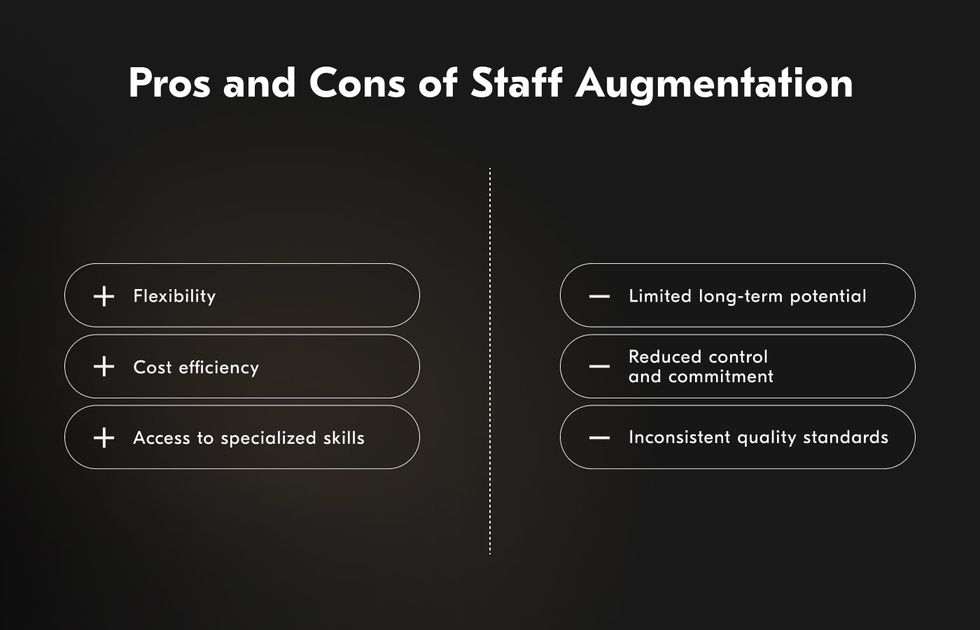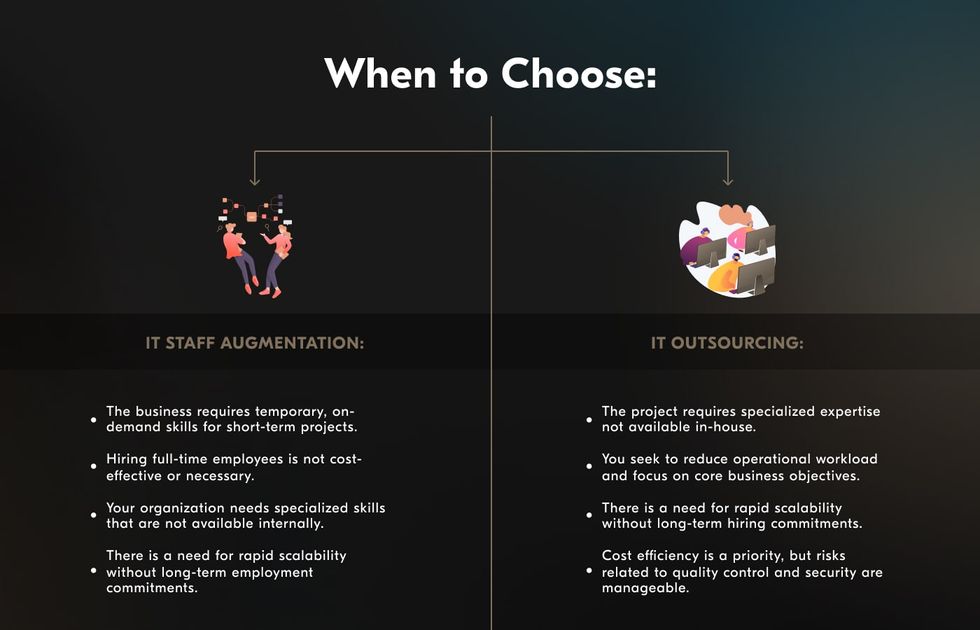
Key Takeaways
The IT outsourcing market is forecasted to hit $591.2 billion in 2025, with global outsourcing expenditures exceeding $1.1 trillion.
Staff augmentation spending is expected to hit $81.87 billion.
Outsourcing enables rapid scaling with minimal internal involvement, while staff augmentation allows businesses to expand teams as needed without long-term hiring commitments.
Choosing between staff augmentation and outsourcing depends on business goals, management preferences, and project scope, requiring careful evaluation of control, cost, and expertise needs.
As the global workforce landscape tends to present new challenges, businesses often require additional tech talent to address skill gaps or execute large projects. Two common workforce expansion models — staff augmentation and outsourcing — help businesses scale without overburdening employees.
Both approaches are gaining traction in the IT industry, with 78% of organizations adopting flexible staffing solutions to enhance workforce strategies and deal with talent shortages in their area.
Despite their frequent conflation, these models differ significantly, where each is designed for specific objectives. Serving as a reliable web development outsourcing company for over 20 years, Acropolium has helped 148 partners find the perfect talent for their projects.
Today, we will compare staff augmentation vs. outsourcing practices, breaking down their benefits, drawbacks, and key distinctions so you can find the most suitable approach.
Staff Augmentation vs. Outsourcing: The Difference

Despite their frequent comparison, IT staff augmentation and outsourcing serve distinct purposes. Outsourcing involves delegating entire projects or specific tasks to an external vendor, which assumes full responsibility for execution, milestone management, and deliverables.
Thus, in 2025, the IT outsourcing market is projected to generate $591.20 billion in revenue by 2025, with global outsourcing expenditures expected to surpass $1.1 trillion.
In contrast, staff augmentation allows companies to temporarily integrate new specialists into their in-house teams to support specific tasks while retaining direct oversight. In other words, the main difference between staff augmentation and outsourcing lies in management control.
An outsourcing provider oversees the entire project, while a staff augmentation vendor supplies skilled professionals and web developers who work under the company’s internal leadership. This difference determines whether a business requires a fully managed service or specialist knowledge to complement its existing workforce.
Meanwhile, staff augmentation spending is estimated to reach $81.87 billion within the same timeframe.
| Factor | Outsourcing | Staff Augmentation |
|---|---|---|
| Team Control & Management | The vendor oversees project execution and management. | Internal management retains full control over augmented staff. |
| Cost Structure | Typically follows a fixed-cost or milestone-based pricing model. | Payment based on hours worked or contract duration. |
| Flexibility & Scalability | Provides full project delegation with minimal internal involvement. | Allows for rapid team expansion based on project needs. |
| Expertise & Responsibility | The vendor assumes full responsibility for deliverables and outcomes. | Your internal team manages augmented specialists. |
Advantages and Disadvantages of Outsourcing

Outsourcing is widely adopted both in large enterprises and startups, as it allows you to delegate specific tasks or entire projects to vendors. While it offers significant benefits, it also comes with certain challenges and risks that you should be aware of when evaluating staff augmentation vs project outsourcing.
Benefits of Outsourcing
Accelerated project timelines. Outsourcing partners possess established processes and focused proficiency in areas such as mobile applications, web development, integrations, and data analytics. Their ability to allocate dedicated teams to a project for a defined period ensures faster turnaround times and efficient execution.
Focus on core functions. Companies often outsource tasks that are outside their primary skills or strategic focus. By delegating these responsibilities, businesses can redirect internal resources toward innovation, business growth, and core competencies.
Access to the global talent pool. Outsourcing web or app development eliminates geographical constraints, granting businesses access to highly skilled professionals in regions like South Asia and Eastern Europe. This expanded talent pool enables companies to find the expertise needed for specific projects without long-term hiring commitments.
Disadvantages of Outsourcing
Hidden costs. Although outsourcing is often perceived as a cost-effective solution, businesses may encounter unexpected expenses related to out-of-scope work, additional revisions, or unforeseen complexities. For that reason, contracts should be carefully reviewed to avoid budget overruns.
Limited cultural and organizational alignment. Remote teams may not fully integrate into a company’s culture, mission, or long-term vision. The lack of alignment in web or app development outsourcing can result in reduced engagement and collaboration challenges, impacting project outcomes.
Data security risks. Another key factor to consider while choosing between staff augmentation vs. IT outsourcing is data processing. Outsourcing implies that businesses need to share sensitive information with third-party vendors. Without proper safeguards, this can lead to data security vulnerabilities, loss of intellectual property control, and compliance risks. This is particularly vital in industries with strict regulatory standards.
When to Outsource?
Outsourcing is most effective in scenarios where:
The project requires specialized expertise not available in-house.
You seek to reduce operational workload and focus on core business objectives.
There is a need for rapid scalability without long-term hiring commitments.
Cost efficiency is a priority, but risks related to quality control and security are manageable.
Advantages and Disadvantages of IT Staff Augmentation

Before deciding between staff augmentation and outsourcing, you should carefully revise the benefits and drawbacks of each model. Deloitte reports that over 78% of organizations are actively considering or have already adopted flexible staffing solutions, such as IT staff augmentation, to strengthen their workforce strategies.
Still, it also has several drawbacks related to long-term growth and consistency.
Benefits of Staff Augmentation
Flexibility. Staff augmentation lets you scale your workforce on demand, adding developers or any other specialists as needed. This model is particularly advantageous for short-term projects requiring temporary expertise without long-term commitments.
Cost efficiency. Augmenting a team with external professionals can be significantly more cost-effective than hiring full-time employees, particularly for companies based in high-salary regions. For example, the median annual salary of a U.S. software engineer is $179,000, whereas in the Czech Republic, it is approximately $58,000. Additionally, can keep away from expenses required for infrastructure, training, and onboarding.
Access to specialized skills. One of the common points between staff augmentation and outsourcing is that it also lets businesses quickly onboard experts in niche technologies or industries. Similarly, it happens without the time-consuming process of permanent recruitment. This model is ideal for companies that need highly skilled professionals for short-term assignments.
Disadvantages of Staff Augmentation
Limited long-term growth potential. Though staff augmentation is ideal for temporary workforce expansion, it is not suited for building a long-term, dedicated team. If you’re looking for sustained growth and team stability, you may find offshore development a more strategic alternative.
Reduced control and commitment. Another staff-augmentation-outsourcing difference is that augmented staff may divide their time across multiple projects or employers. This can result in inconsistencies, requiring your managers to frequently onboard and familiarize new team members with their workflows and software requirements.
Inconsistent quality standards. A well-functioning web development team relies on standardized processes and best practices. When working with augmented engineers, businesses may encounter misalignment in work quality, as remote professionals may not fully adapt to the company’s established methodologies.
When to Go for Staff Augmentation?
Staff augmentation is most suitable when:
The business requires temporary, on-demand skills for short-term projects.
Hiring full-time employees is not cost-effective or necessary.
Your organization needs specialized skills that are not available internally.
There is a need for rapid scalability without long-term employment commitments.
Choosing the Right Model for Your Software Development Needs: IT Staff Augmentation vs. Outsourcing

Knowing the difference between staff augmentation and outsourcing is your first step toward the right choice, which depends on project scope, management preferences, and long-term business objectives. Both models offer access to skilled professionals, however, they differ in terms of control, scalability, and cost structure.
With outsourcing, you can leave up entire projects or specific tasks to a dedicated team, benefiting from faster project execution, access to global talent, and reduced internal workload. However, it may present hidden development costs, cultural misalignment, and data security risks. Outsourcing is ideal when specialized expertise is required, scalability is a priority, and long-term hiring is not feasible.
Staff augmentation, in contrast, integrates external professionals into an internal team, offering greater flexibility, cost efficiency, and niche skills. Yet, it comes with challenges such as limited long-term growth, reduced control, and potential inconsistencies in quality. This model works perfectly for short-term projects.
Why choose Acropolium as a reliable outsourcing partner?
Acropolium is a trusted technology partner with over 20 years of experience in software development and IT consulting. We help businesses — ranging from startups to Fortune 500 players — not only build bespoke software but also identify the right talent and cooperation model to fit their needs.
Whether you require backend developers, solution architects, or cloud engineers, we provide specialized skills to optimize your project’s success.
Our experience spans transportation, energy, hospitality, healthcare, fintech, and more. We modernize legacy systems, build sophisticated SaaS products, and ensure seamless digital transformation.
With deep expertise in GDPR-compliant software development, ISO-certified processes, and serverless solutions, we uphold the highest standards of security, compliance, and scalability. This way, we will not just help you decide between staff augmentation vs. outsourcing but navigate complex technical challenges with confidence.
Acropolium Case Studies
Having delivered over 450 solutions for businesses from different sectors, we know how transformative the right choice of talent and staffing models can be. Here are some success stories with real-world proof.
Multi-Functional Crypto Wallet
A fintech company specializing in digital asset management sought to develop a secure, customizable, and scalable cryptocurrency wallet. Existing third-party solutions lacked the required security features, customization options, and regulatory compliance. The client required a multi-functional wallet supporting multiple currencies, token swaps, fiat conversions, and DeFi integrations, while ensuring future scalability and adherence to global financial regulations.
Solution
Since our partner didn’t know whether to choose staff augmentation or outsource app development, we first provided a consultation on each model’s pros and cons.
Acropolium conducted a comprehensive discovery phase to define key requirements and technical challenges. We developed a custom cryptocurrency wallet with:
Multi-signature functionality, private key encryption, and two-factor authentication.
A unified, intuitive interface for web, Android, and iOS using React and React Native.
Web3.js and Ethers.js for seamless integration with multiple blockchains.
Token swaps, staking, and smart contract execution using Solidity on Ethereum.
Full adherence to GDPR, AML, and KYC standards.
A secure Node.js backend and AWS infrastructure to support growing data requirements.
Results
35% reduction in service downtime, increasing platform reliability and user trust.
25% improvement in operational efficiency, optimizing customer support and issue resolution.
25% boost in user acquisition, driven by enhanced security, advanced features, and an improved user experience.
AI-Driven Pharmacy App
A leading healthcare provider partnered with Acropolium to digitize operations and enhance patient care through AI-based pharmacy app development. The client required a prescription automation system with integrated patient engagement tools, including personalized medication reminders and virtual consultations.
Solution
Leveraging machine learning, we minimized prescription errors and optimized inventory management, ensuring a streamlined and efficient healthcare workflow. Our key deliverables included:
Real-time medication validation and virtual pharmacist consultations to enhance patient support.
A user-centric interface with personalized features, such as medication reminders and health tracking tools.
Automated prescription workflows, improving management efficiency and reducing manual processing.
Secure data storage with full compliance with EU regulations and GDPR for patient data protection.
Results
30% increase in efficiency by automating inventory and prescription management, reducing manual workload.
Scalable infrastructure, reducing operational costs and adapting to growing demand.
15% increase in customer retention, driven by improved patient engagement and personalized services.
25% reduction in data breach risks, ensuring regulatory compliance and strengthening patient trust.
Final Thoughts
When selecting between staff augmentation vs. outsourcing, the choice depends on your business’s unique needs and long-term goals. Both approaches offer strategic advantages, enabling companies to scale efficiently, access specialized talent, and adapt to evolving market conditions. A well-balanced resource management strategy will ensure that your businesses remain agile amid technological advancements and shifting demands.
At Acropolium, we go beyond software development — we provide expert consulting to help businesses identify the right talent and collaboration model. From our side, we offer you options, among which there’s an opportunity to cooperate on a subscription basis.
Contact us today to discuss your needs, and let’s build the right strategy for your success.









![8 Risks of Software Development Outsourcing [Their Solutions]](/img/articles/software-development-outsourcing-risks/img01.jpg)
![In-House vs Outsourcing [What to Choose in 2025]](/img/articles/in-house-vs-outsourcing-software-development-what-to-choose/img01.jpg)

![Offshore Mobile App Development: [Benefits, Best Practices, and Cost]](/img/articles/offshore-mobile-app-development-benefits-best-practices-and-cost/img01.jpg)
![Nearshore Software Development: [2025 Guide]](/img/articles/a-guide-to-nearshore-software-development-find-the-best-outsourcing-model/img01.jpg)
![Outsourcing vs. Outstaffing Comparison [Which to Choose in 2025?]](/img/articles/outsourcing-vs-outstaffing/img01.jpg)